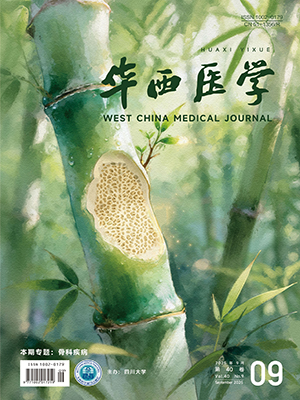| 1. |
Sindhuja T, Bhari N, Gupta S. Asian guidelines for condyloma acuminatum. J Infect Chemother, 2022, 28(7): 845-852.
|
| 2. |
Gilson R, Nugent D, Werner RN, et al. 2019 IUSTI-Europe guideline for the management of anogenital warts. J Eur Acad Dermatol Venereol, 2020, 34(8): 1644-1653.
|
| 3. |
中华医学会皮肤性病学分会, 中国医师协会皮肤科医师分会, 中国康复医学会皮肤性病委员会. 中国尖锐湿疣临床诊疗指南(2021 完整版). 中国皮肤性病学杂志, 2021, 35(4): 359-374.
|
| 4. |
Zhang Y, Ni Z, Wei T, et al. Persistent HPV infection after conization of cervical intraepithelial neoplasia-a systematic review and meta-analysis. BMC Womens Health, 2023, 23(1): 216.
|
| 5. |
陆小年, 徐金华. 尖锐湿疣治疗专家共识(2017). 临床皮肤科杂志, 2018, 47(2): 125-127.
|
| 6. |
耿建祥, 黄华艺, 刘建华, 等. HPV 感染疾病相关问题专家共识(2017). 医学研究生学报, 2017, 30(12): 1238-1241.
|
| 7. |
Dahlstrom KR, Day AT, Sturgis EM. Prevention and screening of HPV malignancies. Semin Radiat Oncol, 2021, 31(4): 297-308.
|
| 8. |
中华医学会皮肤性病学分会性病学组, 中国医师协会皮肤科分会性病亚专业委员会. 尖锐湿疣临床诊疗与防治指南(一). 中国艾滋病性病, 2015, 21(2): 172-174.
|
| 9. |
Patel H, Wagner M, Singhal P, et al. Systematic review of the incidence and prevalence of genital warts. BMC Infect Dis, 2013, 13: 39.
|
| 10. |
岳晓丽, 龚向东, 李婧, 等. 2008—2016 年中国性病监测点尖锐湿疣流行特征分析. 中华皮肤科杂志, 2017, 50(5): 321-325.
|
| 11. |
杨戈, 崔凡, 雍刚, 等. 多重感染尖锐湿疣皮损 HPV 基因型别回顾性分析. 中国艾滋病性病, 2019, 25(7): 718-721.
|
| 12. |
李茜瑶, 徐敏, 卢红艳. 2011—2021 年北京市尖锐湿疣流行病学特征. 中国艾滋病性病, 2023, 29(8): 922-923.
|
| 13. |
张婉筠, 赵山平, 王晶莹, 等. 昆明市 2016 年性传播疾病流行病学分析. 皮肤病与性病, 2017, 39(6): 412-416.
|
| 14. |
樊庆莹, 邓宝清, 温桂春, 等. 2009—2018 年深圳市宝安区尖锐湿疣流行特征分析. 中国皮肤性病学杂志, 2020, 34(5): 559-562.
|
| 15. |
李秋玲, 赖新平, 钟宗远. 国家性病监测点广东省兴宁市 2007—2014 年间 5 种性病流行特征分析. 皮肤性病诊疗学杂志, 2016, 23(4): 277-279.
|
| 16. |
钟慧钰, 刘堂喻亨, 王旻晋, 等. 流式荧光杂交技术检测四川大学华西医院体检女性人乳头瘤病毒感染亚型分布. 华西医学, 2019, 34(8): 895-899.
|
| 17. |
Zhao FH, Tiggelaar SM, Hu SY, et al. A multi-center survey of HPV knowledge and attitudes toward HPV vaccination among women, government officials, and medical personnel in China. Asian Pac J Cancer Prev, 2012, 13(5): 2369-2378.
|
| 18. |
李丰田, 田颖新, 童红莉, 等. 2012—2022 年某综合医院门诊男性患者人乳头瘤病毒感染状况和基因型分布. 中华医院感染学杂志, 2023, 33(22): 3447-3451.
|
| 19. |
范昉, 尹婧, 刑建军, 等. 男性尖锐湿疣患者 HPV 基因型和临床特征及其复发的危险因素. 中华医院感染学杂志, 2023, 33(11): 1690-1694.
|
| 20. |
王剑磊, 朱天, 韩玉, 等. 男性尖锐湿疣患者人乳头瘤病毒基因型分布特点及复发危险因素. 首都医科大学学报, 2023, 44(1): 148-153.
|
| 21. |
Yang EJ, Quick MC, Hanamornroongruang S, et al. Microanatomy of the cervical and anorectal squamocolumnar junctions: a proposed model for anatomical differences in HPV-related cancer risk. Mod Pathol, 2015, 28(7): 994-1000.
|
| 22. |
陈少强, 吴颖, 谢艳, 等. 2020—2022 年湖南省 326824 名宫颈癌筛查和健康体检者 HPV 感染率及亚型分布. 中华肿瘤防治杂志, 2024, 31(7): 399-404.
|
| 23. |
García-Carrasco M, Mendoza-Pinto C, Rojas-Villarraga A, et al. Prevalence of cervical HPV infection in women with systemic lupus erythematosus: a systematic review and meta-analysis. Autoimmun Rev, 2019, 18(2): 184-191.
|
| 24. |
Doorbar J. Latent papillomavirus infections and their regulation. Curr Opin Virol, 2013, 3(4): 416-421.
|




